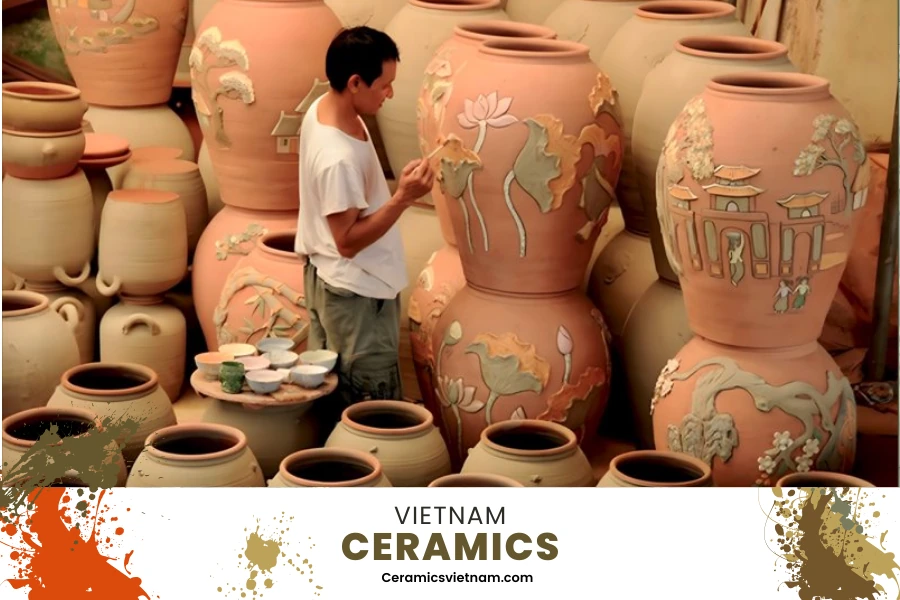As the largest and most famous pottery village in Vietnam, Bát Tràng (Gia Lâm, Hanoi) is known for its diverse range of products, including household items, toys, decorative ceramics, and religious items. Every Tet (Lunar New Year) and spring season, it becomes an attractive destination for both domestic and international tourists to visit and shop.
The capital’s attractive tourist destination during Tet

Pottery Village Bát Tràng in the digital transformation era
Located on the banks of the Red River in Gia Lam district, Bát Tràng is the oldest and most famous pottery village in Vietnam. The ancient Bát Tràng village covers an area of 5.2 hectares with hundreds of years of history, featuring 23 ancient houses and 16 ancestral temples constructed with traditional Bát Tràng bricks. Bát Tràng is also recognized as a historical and cultural area with nine valuable sites, including Tiêu Giao Pagoda, Giang Cao Communal House, Bản Temple, Bát Tràng Communal House, Mẫu Temple, Kim Trúc Pagoda, and the Bát Tràng Village Stele.
The Tieu Dao Pagoda, located in Giang Cao village, Bát Tràng commune, Gia Lâm district, is an ancient temple renovated using ceramic tiles, creating a unique ceramic structure that embodies the cultural essence of the pottery village harmonizing with spiritual culture.
Before 1945, the Tieu Dao Pagoda was a gathering place for many revolutionary activists and served as a hiding place for confidential documents. It was here that the song “Tiến quân ca” (Marching Song) by the late musician Van Cao was disseminated to the public. In 2011, when Master Thich Bao Duc became the abbot, he and the Buddhist followers in the village carried out the renovation with the idea of incorporating the essence of the pottery village into the spiritual architecture, creating a unique character for the temple. The artisans of Bát Tràng pottery village devoted all their efforts and talents to create unique ceramic products, such as the incense burner crafted in the ancient Nguyen style, and worship statues. In addition, from the temple’s roof ridge, horizontal lacquered boards, altar, to the exterior decorative columns, all are made of ceramic tiles
Presently, Bát Tràng consists of over 11 hamlets with more than 8,500 residents and over 1,000 households engaged in pottery production and business. The village has a network of shops along the road from Giang Cao village to Bát Tràng, showcasing and selling a wide variety of beautiful and diverse ceramic products suitable for various types of visitors and shoppers. This contributes to stable employment and income for tens of thousands of workers, both local and from other regions.
Various types of kilns can be found here, including frog-shaped kilns, drum kilns, belly-shaped kilns, box kilns, and gas kilns. Among them, the belly-shaped kiln is the largest and capable of reaching the highest firing temperature. The ceramic products vary in both type and design. In recent years, Bát Tràng has continuously innovated its production technology and product designs. Bát Tràng ceramic products are now of interest and favored by many countries and are present in major markets worldwide, such as France, Japan, South Korea, Russia, and Italy.
In addition to developing mainstream products, many artisans and skilled craftsmen have restored ancient ceramic pieces used in feudal periods, such as ceramics from the Ly, Tran, and Mac dynasties. They have successfully restored and crafted many unique glaze formulas.
Community tourism development is one of the ways to make Bát Tràng an attractive tourist destination in the capital. Every year, Bát Tràng welcomes over 200,000 domestic and international visitors, with international visitors accounting for more than 20%. Currently, Bát Tràng is implementing a detailed plan for the preservation and development of the traditional craft village combined with tourism at a ratio of 1:500. This plan includes the construction of facilities such as the Bát Tràng Ceramic Trade Center, the ceramic museum area, and riverside hotels along the Bac Hung Hai River. This is the core of tourism development, aiming to preserve and elevate the value of the traditional ceramic craft, turning Bát Tràng into an international tourist destination.
Simultaneously, Bát Tràng has been developing smart tourism based on the application of Industry 4.0 technology. Visitors can learn about the craft village, historical sites, standard shopping points, and tour routes by scanning QR codes. They can also use automatic narration applications available in multiple languages and access free Wi-Fi.
Ms. Hà Thị Vinh, Chairwoman of the Handicraft and Craft Villages Association of Hanoi, shared that the digital transformation is bringing specific changes to Bát Tràng’s tourism. Additionally, Bát Tràng is recognized as one of the first craft villages in Hanoi to apply digital technology for “smart tourism.” The Bát Tràng commune has completed the construction of a digital resource database, a digital map of cultural and tangible heritage, tourism, services, and trade in Bát Tràng in the form of 3D films, audio recordings, images, and text. The smart tourism software is applied on smartphones, and free Wi-Fi has been installed. On average, Bát Tràng welcomes from 3,000 to 5,000 visitors each day.
Bringing products to distant customers through digital technology

Pottery Village Bát Tràng in the digital transformation era
The arrival of Tet and the spring season is also the time when the pottery village of Bát Tràng gears up for production. However, nowadays, visitors to Bát Tràng are predominantly tourists and sightseers, enjoying a leisurely stroll and scenic views, rather than avid shoppers carrying baskets and boxes as in previous years. The bustling shopping atmosphere may have diminished, but that doesn’t mean the pottery kilns have gone cold. Embracing digital technology and incorporating it into both production and product promotion, Bát Tràng is gradually transforming itself to reach traditional craft products to customers across the globe.
“In addition to the craft itself, whether customers are aware of the products we create requires the flexibility and creativity of the seller, which involves the application of digital technology. Each production facility has its main product, but the key to success lies in mastering digital platforms,” said Nguyen Thi Thanh Thuong, a ceramic artisan.
Despite practicing the traditional craft for over 10 years, Thương’s business still relies mainly on existing family trade connections. Expanding the market, especially during the COVID-19 pandemic, has been challenging. However, since incorporating digital technology, the production and business of Thương’s family have shown signs of vitality.
Artisan Vu Nhu Quynh shared, “My workshop produces spiritual ceramics, 3D relief patterns requiring meticulous and skillful techniques, not only for high aesthetic values but also for effectively introducing cultural elements into each product, making each piece tell a story and captivating the viewer.”
“Since applying digital platforms to product promotion, some customers from as far as Ca Mau, even overseas, have become aware of our store’s products. Nowadays, transactions mainly occur through social media. Customers don’t necessarily have to touch the products physically, but we must present clear and authentic images. Putting our products online requires technical skills, but we also need to build a brand identity for each type of product, associating each design with a story – that is the essence of the product. Once the story touches the customer’s heart, delivering the product to the customer is only a matter of time. The intermediary costs are also much lower,” confided artisan Vu Nhu Quynh.
According to Quynh, selling products through digital technology is convenient, with low intermediary costs and broad outreach. Therefore, despite economic challenges this year, with the application of digital technology in production and sales, Bát Tràng ceramics continue to sell in the domestic and international markets.
The current prominence of Bát Tràng is not only due to the attention of the city and local authorities but also the active involvement of the local community, those who are preserving the traditional flame of the craft. These factors contribute to the continuous rise of Bát Tràng tourism, making it a destination not only for the city but also on the international map in the future.














Leave a reply